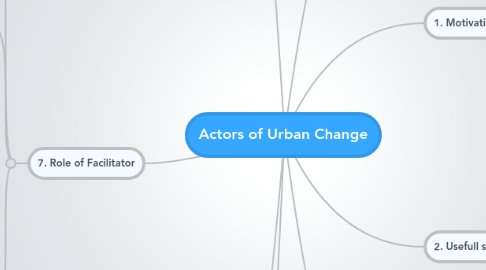
1. 6. Kick off - Process
1.1. Before Berlin
1.1.1. Approval of 12 projects
1.1.1.1. Different themes and geograhpies
1.1.2. Logistics -. travel and accomodation
1.1.2.1. Creates a bond in the teams
1.1.3. Expectations and excitement
1.1.3.1. Communicate with other teams
1.1.3.1.1. Set up a blog, Facebook page or similar
1.2. In Berlin
1.2.1. Informal space - one (long) day
1.2.1.1. Talking about space
1.2.1.1.1. Who are the actors
1.2.1.2. "taking the space"
1.2.1.2.1. Making Change very concrete
1.2.1.3. Getting urban
1.2.1.3.1. Walking in the neighbourhood - creating a common and urban narrative.
1.2.1.4. The 12 projects are presented
1.2.1.4.1. Project development - "Kill your Darlings workshops"
1.2.1.4.2. Common themes and possibilities are being developed
1.2.2. Dialogical space - two days
1.2.2.1. 4 masterclasses based on 4 themes
1.2.2.1.1. Groups with each 3 teams - for every new theme the groups are being shuffled.
1.2.2.1.2. one theme in the morning and one in the afternoon
1.2.2.1.3. 4 experts in Communication, Collaboration, urban knowledge and project development each give a half day masterclass.
1.2.2.1.4. Each masterclass are wrapped up with the 4 groups presenting their findings
1.2.2.1.5. Evenings are for the groups to keep working or people to hang out.
1.2.3. Formal space - one Long day
1.2.3.1. More formal networks are agreed
1.2.3.1.1. Shadow internships
1.2.3.1.2. how the three Academies will be
1.2.3.1.3. Other types of exchange of knowledge
1.2.3.2. Big map with people, Projects, and their new connections
1.2.3.3. Public Event
1.2.3.3.1. Presentation of the projects
1.2.3.3.2. Visible to the city
1.2.3.3.3. 4 themes and four groups
1.3. After Berlin
1.3.1. Back home with new inspiration and energy
1.3.1.1. Communicating with the rest
1.3.1.1.1. Using the Facebook page/blog
1.3.2. Preparing for the next sessions
2. 7. Role of Facilitator
2.1. Participants
2.1.1. Maximum 36 participants (Kick-off Forum)
2.2. Program management
2.2.1. Martin, plus 3 more
2.2.1.1. Defining the process and deciding on the methods
2.2.1.2. Choosing/inviting the experts for the masterclasses
2.2.1.3. Presents the overall project
2.2.1.4. Tells about the stiftung
2.2.1.5. Doing one ore more masterclass
2.2.1.6. Take part in discussions
2.2.1.7. Wraps up the process
2.3. The facilitator
2.3.1. Creating a process that will achieve the goals of the programme - developing the process with the program management
2.3.1.1. one week
2.3.2. Prepare the process - all the logistics that are nessecary
2.3.2.1. Program management will be part of this i guess so a division of labour is nessecary
2.3.2.1.1. one week
2.3.3. Facilitation
2.3.3.1. Making sure that the experts understand the process and the overall programme (together with the program management)
2.3.3.2. Making sure that the participants understands the process
2.3.3.2.1. One and a half week
2.3.3.3. Making sure that the process is being followed in both a smooth and informal way
2.3.4. Evaluation
2.3.4.1. Follow up on the process
2.3.4.1.1. Half week
2.3.4.2. Next step
3. Actors of Urban Change
3.1. Change
3.1.1. Nature reference
3.1.1.1. Evolution
3.1.1.1.1. adapt to or take advantage of new situations
3.1.1.1.2. prevents stagnation and krisis
3.1.2. Urban reference
3.1.2.1. Fixed situations
3.1.2.1.1. Make people stop thinking of change
3.1.2.1.2. Example: suburbs and big homogenous "bloks"
3.1.2.2. Signs of change or evolution
3.1.2.2.1. Can inspire to change
3.2. Urban
3.2.1. Nature reference
3.2.1.1. Free movement
3.2.1.2. Faunapassages
3.2.1.3. Voting with your feet
3.2.2. Fragmentation
3.2.2.1. Breaking barriers
3.2.2.2. Crossectorial collaboration
3.2.2.3. Working across gender, social, ethnic and age barriers
3.3. Actors
3.3.1. Nature reference
3.3.1.1. Evelution sparked by bees
3.3.2. Urban reference
3.3.2.1. Cross pollinations in many different ways
4. 5. Program
4.1. Main Focus
4.1.1. Kick Off
4.1.1.1. Opening up - listening, learning skills and building networks
4.1.1.1.1. From informal to a Dialogical space
4.1.2. 3 Academies
4.1.2.1. Local and more hands on
4.1.2.1.1. Dialogical space
4.1.3. Final event
4.1.3.1. Production of new common knowlegde
4.1.3.1.1. Formalising the Dialogical space
4.2. Skills developed - 4 Themes
4.2.1. Urban Structure
4.2.1.1. Power Structure
4.2.1.1.1. What is political
4.2.1.1.2. Local influence?
4.2.1.1.3. Inclusion/exclusion
4.2.1.2. Spatial structure
4.2.1.2.1. Formal and informal spaces
4.2.1.2.2. Gentrification/Segregation
4.2.2. Collaboration Communication
4.2.2.1. workshop methods, Group dynamics, Constructive dialogue
4.2.2.2. Tools, target groups
4.2.3. Urban Culture
4.2.3.1. Cultural trategies, Activism and Actors
4.2.3.2. Culture of Change
4.2.3.2.1. Sustainable
4.2.4. Project development
4.2.4.1. Networking, Funding, Local ressources
5. 3. Background
5.1. Sculpture and Theatre
5.1.1. Hotel Pro Forma
5.2. Urban development - in administration and as an activist
5.2.1. Helsinore
5.2.1.1. Andrea Zittel
5.2.2. Supertanker
5.2.2.1. Christian Nold
5.2.2.2. Spatial Agency
5.2.2.3. Rediscovering the spatial
5.3. CiTyBee
5.3.1. Community Tool Box
5.3.1.1. Spatialising the dialogue about space
5.3.2. Creating af dialogical space
5.3.2.1. Crosspollination
5.3.3. Offshoots
5.3.3.1. Locally grown initiatives (change)
5.3.3.2. Sustainable urbanity
6. 1. Motivation
6.1. Great potential in exchanging experience and building networks on an international level.
6.2. Trained as an architect
6.2.1. Refer to a diverse backround below
6.2.2. Studies at Weissensee, Berlin
6.3. Building on a number of experiences
6.3.1. Working/dreaming on a nomadic project
6.3.2. BRU grassroots conference
7. 2. Usefull skills
7.1. Network
7.1.1. Personal and professional knowledge
7.1.1.1. Most European Countries - including Belarus
7.1.2. Knowledge from living
7.1.2.1. Berlin, Zagreb, Geneva, Copenhagen
7.2. Language
7.2.1. Everyday - spoken
7.2.1.1. French, Croatian
7.2.2. Almost fluent speaking and reading
7.2.2.1. German
7.2.3. Fluent speaking, reading and writing
7.2.3.1. English, Danish
7.3. Communication
7.3.1. Office and Adobe
7.3.2. Blogs and social media
8. 4. Methods
8.1. Informal Space
8.1.1. Open and listening.
8.1.1.1. Involving people to participate
8.1.1.2. Feeling good. Making people speak up
8.2. Dialogical Space
8.2.1. Inspiring and constructive
8.2.1.1. Making differences visible and clear
8.2.1.2. Cross pollinating between people with different ideas
8.2.1.3. Spatial prototypes as one way of dialogue
8.3. Formal space
8.3.1. Producing results
8.3.1.1. Visible and usefull products
8.3.1.2. New knowledge and terms
8.3.1.3. New networks
